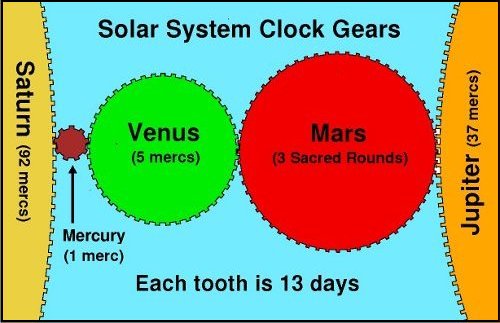
by John P. Pratt
2 Sep 2014, 1 Creation (V), 1 Light (SR)
©2014 by John P. Pratt. All rights Reserved.
| 1 The Merc |
| 2. Uniform Mercury Calendar |
| 2.1 Phases |
| 2.2 Correlation to Gregorian |
| 2.3 Correlation to Uniform Venus |
| 3. Witness with Mercury and Venus |
| 3.1 John the Baptist |
| 3.2 Annunciation and Birth of Isaac |
| 4. Conclusion |
| Notes |
This article introduces the Uniform Mercury Calendar. A recent article summarized three decades of work on ten sacred calendars.[1] This new calendar brings the total to eleven.
There are two types of sacred calendars. One type actually tracks the location of a planet (or other celestial body) in the heavens. Each has a distinct pattern, based usually on key orbital points. Each also needs to occasionally insert or skip "leap days" to accurately follow it, because the true cycle length never is an exact number of days. Examples of this type of calendar are the Venus and Mercury calendars.
The other type of sacred calendar is the "uniform" type. It does not actually track the planet at all. It uses the same pattern as the first type calendar, but it never inserts or skips days. It is actually just a way to bundle days together to keep track of them. Thus, the Uniform Mercury Calendar employs exactly the same pattern as the Mercury Calendar, without ever changing it at all.
 |
The other fundamental unit of planetary periods is the 260-day Sacred Round. Both are based on the even more basic unit of the 13-day "trecena". The trecena is a repeating cycle of 13 days, which just goes on indefinitely, numbering days from 1 to 13, much like the week is a repeating cycle of 7 days. It is a simple day count; no "leap days" are ever inserted into the cycle. The merc is a set of 9 trecenas (9 x 13 = 117) and the Sacred Round is a set of 20 trecenas (20 x 13 = 260).
Figure 1 illustrates the use of these two units in the cycles of the visible planets. The period of Mercury is very nearly 1 merc, represented by the little Mercury gear. That wheel is shown with 9 teeth, each of which represents one trecena. The period of Venus is nearly exactly equal to 5 mercs, which is 585 days.[3] The period of Jupiter is 37 mercs and of Saturn is 92 mercs. The period of Mars is exactly 3 Sacred Rounds to the very day (3 x 260 = 780 days).
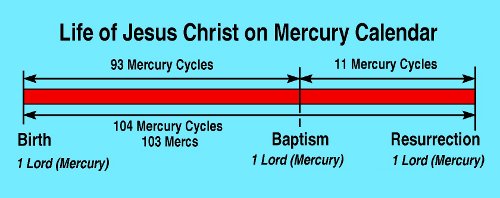 |
That same period of 12,051 days is an important unit in itself because it is two different realignment intervals. A "realignment interval" is a period of time which is the shortest in which two or more other cycles realign with each other. For example, the merc of 117 days and the true Mercury Cycle of 115.877538 days. If the two cycles begin aligned with each other, then with each succeeding merc, the two cycles will get more and more out of alignment. That is, after one merc, the planet will be about 1.12 days short (117 - 115.88), and after two cycles it will be 2.24 days short, and so on. But no correction is made for about 3.7 years, when an entire trecena is skipped. How long does it take until the two cycles line up again? That will happen when 9 trecenas have been skipped, which takes 33 years. The precise answer is 103 mercs, or 12,051 days! So 103 mercs is a realignment interval for the merc and the Mercury Cycle, meaning that there is no shorter period which realigns the two cycles so well. 12,051 days is also a realignment interval for the Mercury Cycle, the trecena and the year.[4] And that period turns out to be exactly the 33-year period from the Savior's birth to resurrection.
The Uniform Mercury Calendar (abbreviated UM) has a cycle of one merc, the same as the Mercury Calendar. Both are divided into 9 phases of one trecena (13 days) each. Each phase represents a step in the cycle of life.
The Venus Calendar has been described in detail in my work and the pattern for Mercury is very similar. Both are the only two planets which are both morning and evening stars. That is because their orbits are nearer to the sun than the earth, so they can never appear in the sky very far from the sun.
 |
The Mercury calendar has not been described in any detail in previous articles. It has always been the "little brother" of the Venus Calendar, and has been described mostly by "ditto for Mercury" after discussing the Venus Calendar in detail (as is being done here). That is because the pattern is very similar. But with this article the Mercury Calendar finally comes into its own as a needed second witness to the Venus Calendar.
The description which follows applies both to the Mercury Calendar and also the Uniform Mercury Calendar. The only difference between them is that about every 3.7 years (11 or 12 Mercury Cycles) the Mercury Calendar skips one trecena in order to actually track the real planet through its phases.
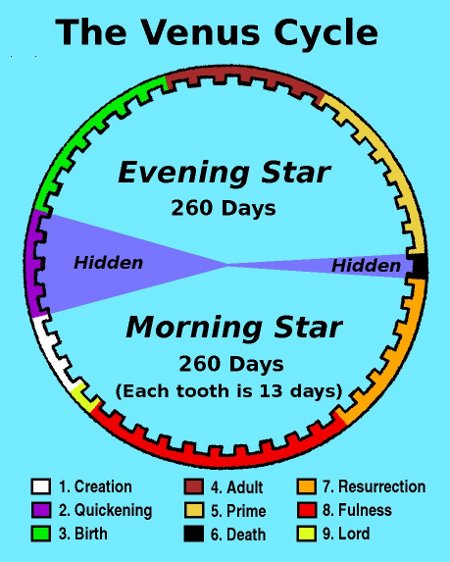 |
Figure 5 shows the same nine phases for Mercury. Here the pattern is much simpler because each of the phases is exactly one trecena in length. That results in the Mercury cycles having a length of 9 x 13 = 117 days (one merc). The starting point for any trecena is defined by the Sacred Round calendar. The same trecenas are used for the Venus, Mercury, Uniform Venus and Uniform Mercury Calendars, so all five calendars are synchronized.
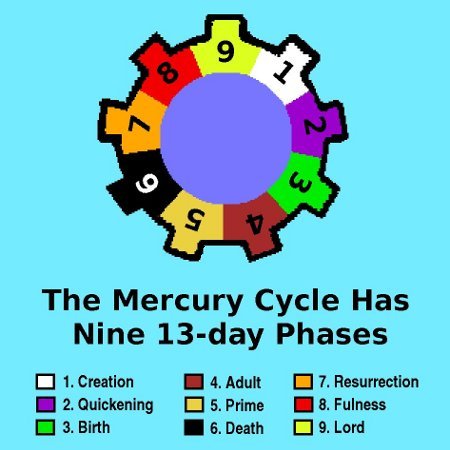 |
Here it should be noted that the calendars which track the planets only follow the average positions of the planets in the sky. The actual positions can very significantly, but the differences are not important to any of the sacred calendars. The pattern is more important than the actual positions which only differ by a few days. It should also be noted that while Venus rises high above the horizon and is visible for some nine months as evening and again as morning star, Mercury is very near the sun and hence is never visible very high above the horizon at all. Then it is visible only for about three weeks at best. Even though it completes more than three cycles per year, usually only one is tilted high for favorable viewing per year as a morning star and another as an evening star.
How does the Uniform Mercury Calendar correlate to our modern Gregorian Calendar? By "correlation" is meant, given any day on one calendar, what is it on the other? In the case of any uniform calendar, it is only necessary to identify one of its days on the Gregorian, and then every other day will be determined. One way is to identify a day on the Gregorian that corresponds to 1 Creation (the beginning day) on the Uniform Mercury Calendar. When that is known, all other dates are automatically determined because there are no "leap days" added or skipped to complicate matters.
The reason that it did not occur to me to try to correlate the two calendars before now was that it seemed it would be a daunting task. After all, every single trecena has two holy days. All ten of the events of the Savior's life discussed in the last article would necessarily fall on a holy day on the Uniform Mercury Calendar no matter what correlation was chosen. It was not obvious how to choose correlation criteria.
Now it seemed to be time to try anyway. One obvious correlation is suggested by what was discussed above about the length of the Savior's life. From His birth to resurrection was both 103 mercs and also 104 Mercury Cycles. On the Mercury calendar, the day of His birth and also of His resurrection was 1 Lord. What if those two days were also both 1 Lord on the Uniform Mercury Calendar?
While checking out that possibility, a very important fact surfaced. When one aligns the date of both the Savior's birth and resurrection with the day 1 Lord on the Uniform Mercury Calendar, it turns out that the day of the Beginning of Mortality, from which the Bible reckons time, would be on the day 1 Creation. That is the first day of the Mercury Cycle. And that would match the day on both the Venus Calendar and Mercury Calendar.
That was an unexpected and stunning alignment. The Beginning of Mortality on the morning of Sun 9 Apr 4001 BC is the time from which all Biblical time is measured, such as the life of Adam. There is so much order seen in the three calendars of Venus, Mercury and now the Uniform Mercury. All of them line up on their first day on that first day of time. No other sure way to tell what was correct appeared, so it was determined to use that correlation: Sun 9 Apr 4001 BC is 1 Creation (UM). Clicking on the Fig. 2 illustration shows that both the birth and resurrection of Christ occurred on 1 Lord on both the Mercury and also the Uniform Mercury Calendars using that correlation.
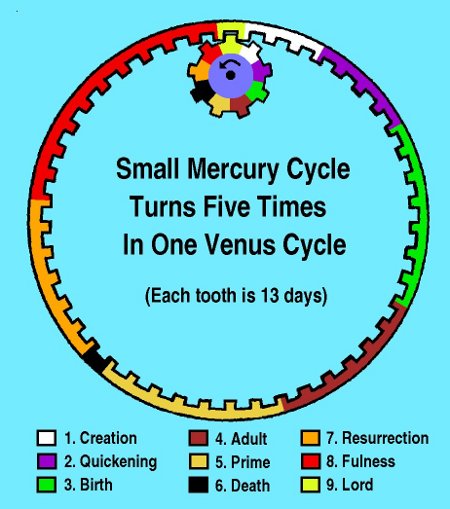 |
A careful check was made of all four hundred dates in the proposed chronology data bank. It turned out that most of the reasons for choosing the original value of correlating the Uniform Venus Calendar were also valid in the new correlation being considered. Changing the correlation date changes all of the former Uniform Venus days, but many of the holy days just changed to different holy days. A few, however, would be lost and some gained. After careful consideration, the new correlation has now been adopted for the Uniform Venus Calendar: Sun 9 Apr 4001 BC is 1 Creation (UV). All UV dates have been changed accordingly on the Religious Chronology page. Those changes are discussed in a separate article today, but overall they greatly strengthen the witnesses provided by the UV calendar.[7]
That correlation is illustrated in Fig. 6 with the two "Lord" phases meshing on both the Uniform Venus and Uniform Mercury gears, as they will do every time. It is also seen that the 1 Creation (UV) will also always align with 1 Creation (UM). Just for the record, 1 Fulness (UV) will also always fall on 1 Fulness (UM), but the other phases do not align in that manner.
The question arises as to the purpose of the Uniform Mercury Calendar. It cannot be an independent second witness to the Uniform Venus Calendar because every day on that calendar will always fall on exactly a fixed date on the Uniform Mercury Calendar. On the other hand, the Uniform Mercury Calendar can indeed be a second witness that the dates of the Venus and/or Mercury calendars are meaningful. It can provide a second witness by being on the same date, or a similar corresponding symbolic dates. Let's look at two examples.
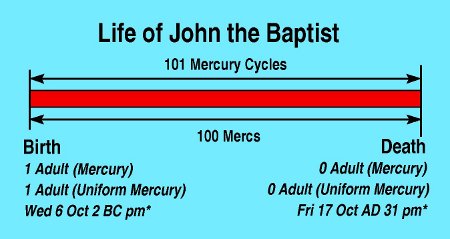 |
Here we are interested only in the Mercury cycles, and the question arises if either his birth or his death was in one of the periods when the Mercury and Uniform Mercury periods aligned with each other. Remember that only happens for about a three year period every 33 years.
The answer is yes. Both his proposed birth and death dates were in periods where the two calendars aligned. The birth date was on 1 Adult on both calendars and the death on 0 Adult on both. In a way that may not be too surprising because he was born only 6 months before Jesus and died only a year and a half earlier. Remember that Jesus' life exactly spanned the 33 year period in which the two calendars would align. But in any case, both the birth and death of John the Baptist did indeed fall into those same two alignment periods.
 |
Then, two days later (Jasher 18:2-4) angels visited both Abraham and Sarah, and they told Sarah about her coming son. What was that all about? Couldn't Abraham have told her?
In an earlier paper, it was shown that the visit of the angels began what was called the "Creation Pattern" on the Venus Calendar, which culminated with Isaac's birth.[9] But now let us look at the Mercury Cycles.
When we look at the date of the angels announcing the birth of Isaac to Sarah and then also look at the day of his birth, we find that the two dates are exactly three mercs apart from each other. The dates are not only the same on both the Mercury and Uniform Mercury calendars, they are all 1 Birth, the one day on both representing birth.
Notice how amazingly these sacred calendars all intertwine. Three mercs is 3 x 117 days = 351 days. The shortest possible year on the Hebrew calendar is 353 days. Abraham had just been given the law of circumcision on the holy day Consecration. He was also told that Sarah would have Isaac on that same holy day next year. Then two days later the angels appear to Sarah and told her about Isaac. So those two days plus the three mercs of 351 days, total 353 days, which was precisely the Hebrew year length that year. Isaac was indeed born on the holy day of Consecration the next year. And on the Venus Calendar these same dates were forming the Creation Pattern. These amazing calendar alignments did not all happen by chance. They had been planned long in advance.
The Uniform Mercury Calendar is introduced and discussed. It has a fixed cycle length of 117 days which has been dubbed the "merc" in former articles. The cycle is divided into the same 9 phases as the Venus Calendars, but in this case all are of equal length of 13 days. Holy days are the first and last days of each phase, the same as the Venus Calendars. The correlation to the other calendars was chosen such that the date of the Beginning of Mortality fell on 1 Creation, the first day of the cycle. Then the correlation of the Uniform Venus Calendar was changed to be likewise so that all four Mercury and Venus Calendars begin on 1 Creation at that time. It was discussed that the interval of 103 mercs from the Savior's birth to resurrection is exactly the period that best realigns the Mercury and Uniform Mercury Calendars. John the Baptist's life and the annunciation and birth of Isaac were given as other examples of when those two calendars aligned. The purpose of the Uniform Mercury Calendar apparently is to be a second witness to the Mercury and Venus Calendars. Together they all provide compelling multiple witnesses of the Creator and of his detailed foreknowledge of key religious events.